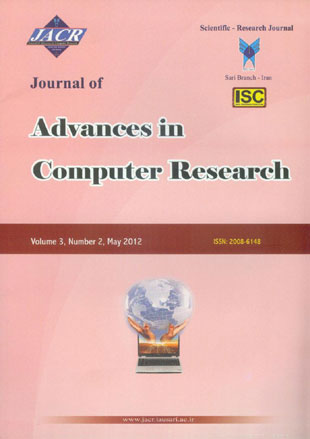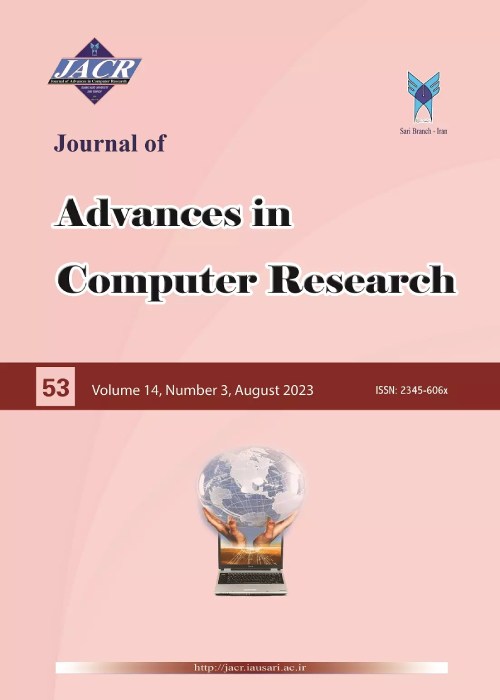فهرست مطالب

Journal of Advances in Computer Research
Volume:3 Issue: 2, Spring 2012
- تاریخ انتشار: 1391/10/11
- تعداد عناوین: 8
-
Page 1Fuzzy rule-based classification system (FRBCS) is a popular machine learning technique for classification purposes. One of the major issues when applying it on imbalanced data sets is its biased to the majority class, such that, it performs poorly in respect to the minority class. However many cases the minority classes are more important than the majority ones. In this paper, we have extended the basic FRBCS in order to decrease the side effects of imbalanced data by employing data-mining criteria such as confidence and support. These measures are computed from information derived from data in the sub-spaces of each fuzzy rule. The experimental results show that the proposed method can improve the classification accuracy when applied on benchmark data sets.Keywords: Imbalanced data, sets, Fuzzy rule based classification systems, Data, mining
-
Page 11Grid computing is a term referring to the combination of computer resources from multiple administrative domains to reach a common computational platform. Mobile Computing is a Generic word that introduces using of movable, handheld devices with wireless communication, for processing data. Mobile Computing focused on providing access to data, information, services and communications anywhere and anytime with all significances. Mobile grids simultaneously are related with traditional grids and mobile computing technologies. This kind of grids inherits all bequests of traditional grid computing and has the trait that supports mobile users and devices in a wireless, Transparent, secure and efficient way. In this paper we suggest a job replica count determiner based on fuzzy inference system to improve mobile grid performance. Simulation results shows that our approach improve parameters like system throughput and network traffic, though job failure rate remains in same condition and mean response time become worse.Keywords: Mobile Grid, Fuzzy Inference System, Job Replication
-
Page 23In today world of internet, it is important to feedback the users based on what they demand. Moreover, one of the important tasks in data mining is classification. Today, there are several classification techniques in order to solve the classification problems like Genetic Algorithm, Decision Tree, Bayesian and others. In this article, it is attempted to classify researchers to “Expert” and “Novice” based on cognitive style factors in order to have as best as possible answers. The domain of this research is based on academic environment. The critical point of this study is to classify the researchers based on Decision Tree and Naïve Bayes techniques and finally select the best method based on the highest accuracy of each method to help the researchers to have the best feedback based on their demands in the digital libraries.Keywords: Data mining, Classification, Cognitive styles, Decision tree, Naïve bayes, Academic environment
-
Page 35Basically, medical diagnosis problems are the most effective component of treatment policies. Recently, significant advances have been formed in medical diagnosis fields using data mining techniques. Data mining or Knowledge Discovery is searching large databases to discover patterns and evaluate the probability of next occurrences. In this paper, Bayesian Classifier is used as a Non-linear data mining tool to determine the seriousness of breast cancer. The recorded observations of the Fine Needle Aspiration (FNA) tests that are obtained at the University of Wisconsin are considered as experimental data set in this research. The Tabu search algorithm for structural learning of bayesian classifier and Genie simulator for parametric learning of bayesian classifier were used. Finally, the obtained results by the proposed model were compared with actual results. The Comparison process indicates that seriousness of the disease in 86.18% of cases are guessed very close to the actual values by proposed model.Keywords: Breast Cancer, Data Mining, Bayesian Classifier, Genie Simulator
-
Page 45Gravitational search algorithm (GSA) is one of the newest swarm based optimization algorithms, which has been inspired by the Newtonian laws of gravity and motion. GSA has empirically shown to be an efficient and robust stochastic search algorithm. Since introducing GSA a convergence analysis of this algorithm has not yet been developed. This paper introduces the first attempt to a formal convergence analysis of the standard gravitational search algorithm which involves with randomness and time varying parameters. In this analysis the behavior of GSA on the facet of mass interaction is considered. The paper provides a formal proof that each object converges to a stable point.Keywords: Analysis of algorithms, Heuristic optimization, Swarm intelligence, Gravitational Search Algorithm, Convergence
-
Page 53Software architecture is considered one of the most important indices of software engineering today. Software Architecture is a technical description of a system indicating its component structures and their relationships, and is the principles and rules governing designing. The success of the software depends on whether the system can satisfy the quality attributes. One of the most critical aspects of the quality attributes of a software system is its performance. Performance analysis can be useful for assessing whether a proposed architecture can meet the desired performance specifications and whether it can help in making key architectural decisions. Architecture style is a set of principles which an architect uses in designing software architecture. Since software architectural styles have frequently been used by architects, these styles have a specific effect on quality attributes. If this effect is measurable for each existing style, it will enable the architect to evaluate and make architectural decisions more easily and precisely. In this paper an effort has been made to introduce a new algorithm for investigating performance in homogeneous architectural styles based on Markov chains. Moreover, How to use this Markov chains model for performance evaluation is shown and simulation and the implications of this transformation are described completely. Finally, to represent the usage of our proposed algorithm, a case study is presented as an example.Keywords: Software architecture, Markov model, Architectural styles, Performance attribute, homogeneous styles
-
Page 65This paper presents a modified digital image watermarking method based on nonnegative matrix factorization. Firstly, host image is factorized to the product of three nonnegative matrices. Then, the centric matrix is transferred to discrete cosine transform domain. Watermark is embedded in low frequency band of this matrix and next, the reverse of the transform is computed. Finally, watermarked image is obtained by multiplying nonnegative matrix components. The experimental results show that the proposed method is transparent and also is high robust against JPEG compression, scaling and median filter attacks.Keywords: Digital image watermarking, Nonnegative matrix factorization, Robustness, Transparency
-
Page 75In this paper, a formal model for antivirus update agent system is presented based on mobile agent technology and predicate/transition Petri nets. The mobile agent system contains two mobile agents called DCA and UNA. It sends out agents to update antivirus on client computers in a network. Each agent takes on a specified responsibility. First, DCA roams through the network and check the last date of updating of antivirus on client computers. Then, by passing the list of unupdated client computers to UNA, next migration is started. The mobile agent system is modeled with logical agent mobility method (LAM) using Petri nets. Each agent is modeled with a predicate/transition Petri net. In this model, the antivirus updating system consists of a set of components to identify different locations and a set of connectors to specify the interactions among the components. Connectors and components are modeled with PrT Nets.Keywords: mobile agents, antivirus update agent system, logical agent mobility


